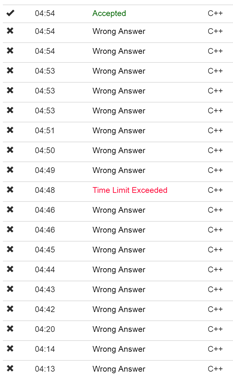
| Online Judge | Online Exercise | Online Teaching | Online Contests | Exercise Author |
|
F.A.Q Hand In Hand Online Acmers |
Best Coder beta VIP | STD Contests DIY | Web-DIY beta |
Dirt Ratio
Time Limit: 18000/9000 MS (Java/Others) Memory Limit: 524288/524288 K (Java/Others)Total Submission(s): 3228 Accepted Submission(s): 1399
Special Judge
Problem Description
In ACM/ICPC contest, the ''Dirt Ratio'' of a team is calculated in the following way. First let's ignore all the problems the team didn't pass, assume the team passed $X$ problems during the contest, and submitted $Y$ times for these problems, then the ''Dirt Ratio'' is measured as $\frac{X}{Y}$. If the ''Dirt Ratio'' of a team is too low, the team tends to cause more penalty, which is not a good performance.

Picture from MyICPC
Little Q is a coach, he is now staring at the submission list of a team. You can assume all the problems occurred in the list was solved by the team during the contest. Little Q calculated the team's low ''Dirt Ratio'', felt very angry. He wants to have a talk with them. To make the problem more serious, he wants to choose a continuous subsequence of the list, and then calculate the ''Dirt Ratio'' just based on that subsequence.
Please write a program to find such subsequence having the lowest ''Dirt Ratio''.

Picture from MyICPC
Little Q is a coach, he is now staring at the submission list of a team. You can assume all the problems occurred in the list was solved by the team during the contest. Little Q calculated the team's low ''Dirt Ratio'', felt very angry. He wants to have a talk with them. To make the problem more serious, he wants to choose a continuous subsequence of the list, and then calculate the ''Dirt Ratio'' just based on that subsequence.
Please write a program to find such subsequence having the lowest ''Dirt Ratio''.
Input
The first line of the input contains an integer $T(1\leq T\leq15)$, denoting the number of test cases.
In each test case, there is an integer $n(1\leq n\leq 60000)$ in the first line, denoting the length of the submission list.
In the next line, there are $n$ positive integers $a_1,a_2,...,a_n(1\leq a_i\leq n)$, denoting the problem ID of each submission.
In each test case, there is an integer $n(1\leq n\leq 60000)$ in the first line, denoting the length of the submission list.
In the next line, there are $n$ positive integers $a_1,a_2,...,a_n(1\leq a_i\leq n)$, denoting the problem ID of each submission.
Output
For each test case, print a single line containing a floating number, denoting the lowest ''Dirt Ratio''. The answer must be printed with an absolute error not greater than $10^{-4}$.
Sample Input
1 5 1 2 1 2 3
Sample Output
0.5000000000
Hint
For every problem, you can assume its final submission is accepted.
Source
| Home | Top |
Hangzhou Dianzi University Online Judge 3.0 Copyright © 2005-2025 HDU ACM Team. All Rights Reserved. Designer & Developer : Wang Rongtao LinLe GaoJie GanLu Total 0.000000(s) query 1, Server time : 2025-03-31 19:49:27, Gzip enabled |
Administration |